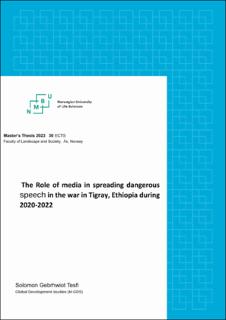| dc.description.abstract | Hate speech plays a significant role in ethnic conflict and war but we lack a good understanding
of how and under what circumstances such discourse correlates with violence. To address this
gap, Maynard and Benesch (2012) proposed the concept of ‘dangerous speech’, and
differentiated between intent and capacity. Understanding the risks associated with disseminating
dangerous speech through mass media may facilitate monitoring, early warning and prevention
of mass violence and is a necessary step in exploring effective forms of
countering dangerous speech. This research examined how dangerous speech shared on
mainstream media has intensified identity-based violence in the Tigray war in Ethiopia that took
place from 2020 to 2022 as well as the role of journalists in relation to dangerous speech. The
study utilized the dangerous speech framework to analyse leaders’ speeches as well as data from
interviews with Ethiopian journalists based on thematic analysis of reports and interview data.
The research identified examples of dangerous speech by government authorities including:
dehumanization, assertion of attack against women and girls, guilt attribution, and threat to group
integrity.
Secondly, it found that state used media in disseminating dangerous speech through
manipulating longstanding historical grievances for political gains and to justify their position
and action while journalists showed loyalty to their ethnic identity and lacked professionalism,
which was evident in their divergent views on national issues such as origin of the Tigray war,
the role of Eritrea in the war, Ethiopian ethnic federalism and future of the country, and this
made it difficult for the journalists to challenge dangerous speech.
Keywords: dangerous speech framework, Tigray war, Ethiopia, media, mass violence | |
